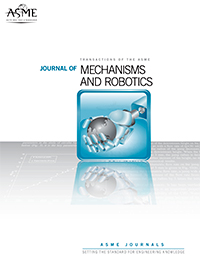As we move into the adolescent years of the 21st century, allow me to discuss where research in mechanisms and robotics has been as a prelude to considering where it is going.
Polynomials
Mechanisms have been characterized by the curves that they trace since the time of Archimedes (1). In the 1800s, Reuleaux, Kennedy, and Burmester formalized this by applying the descriptive geometry of Gaspard Monge to the analysis and synthesis of machines (2). Watt invented a straight-line linkage to convert the linear expansion of steam into the rotation of the great beam, making the steam engine practical (Fig. 1), and captured the imagination of the mathematician Chebyshev, who introduced the mathematical analysis and synthesis of linkages. About the same time, Sylvester, who introduced the Sylvester resultant for the solution of polynomial equations, went on to lecture about the importance of the Peaucellier linkage, which generates a pure linear movement from a rotating link (3). Influenced by Sylvester, Kempe developed a method for designing a linkage that traces a given algebraic curve (4) that even now inspires research at the intersection of geometry (5,6) and computation.
In the mid-1950s, Denavit and Hartenberg introduced a matrix formulation of the loop equations of a mechanism to obtain polynomials that defined its movement (7). During a speech in 1972, Freudenstein famously used the phrase “Mount Everest of kinematics” to describe the solution of these polynomials for the 7R spatial linkage (8). In this context, the “solution” is not a single root but an algorithm that yields all of the roots of the polynomial system, which in turn defines all of the configurations of the linkage for a given input.
It was immediately recognized that the 7R analysis problem was equivalent to solving the inverse kinematics for a general robot manipulator to obtain the configurations that are available to pick up an object. By the end of the 1970s, Duffy (9) formulated an efficient set of equations for this problem, but it was not until the late 1980s when the degree 16 polynomial that yields the 16 robot configurations was obtained by Lee and Liang (10).
By the mid-1990s, computer algebra and sparse resultant techniques were the most advanced tools for formulating and solving increasingly complex arrays of polynomials obtained in the study of mechanisms and robotics systems (11,12). In 1996, Husty used computer algebra to reduce eight quadratic equations in eight soma coordinates that locate the end-effector of a general six-legged Stewart platform to a degree 40 polynomial (13), which allowed the calculation of the 40 configurations of the system.
Computers
In 1959, Freudenstein and Sandor (14) used the newly developed digital computer and the loop equations of a linkage to determine its dimensions, initiating the computer-aided design of mechanisms. Within 2 decades, the computer solution of the equations introduced by Denavit and Hartenberg was integral to the analysis of complex machine systems (15,16) and the control of robot manipulators (17).
Kaufman et al. (18,19) combined the computer’s ability to rapidly compute the roots of polynomial equations with a graphical display to unite Freudenstein’s techniques with the geometrical methods of Reuleaux and Burmester to form KINSYN, an interactive computer graphics system for mechanism design (Fig. 2). This was followed by the LINCAGES system of Erdman et al. (20,21) and the RECSYN system of Chuang et al. (22), which combined sophisticated computer graphics and polynomial solvers to implement Burmester’s strategy for linkage synthesis. Computerized linkage synthesis was extended to spherical linkages (23,24) and spatial linkages (25) by the turn of the 21st century.
The pursuit of solutions to the design equations for the particularly challenging problem of finding a four-bar linkage that traces a curve through nine specified points led Freudenstein and Roth (26,27) to develop a unique solution strategy, now called numerical continuation. They started with a set of polynomials with a known solution, which was then deformed slightly, and the solution was updated numerically. Iterating this “parameter-perturbation procedure,” they obtained a sequence of polynomials and solutions that converged to the target polynomials and the desired solution. While this yielded the first solutions to the nine-point problem, their heuristic deformation procedure could not find all of the solutions.
By the 1980s, theoretical advances in numerical continuation yielded algorithms that could reliably and efficiently find all solutions to small sets of polynomial equations (28,29). Tsai and Morgan (30) applied the polynomial continuation routine SYMPOL to the eight quadratic polynomials of the inverse kinematics problem for a general manipulator and obtained 16 roots in 4 min. In the early 1990s, Wampler and Morgan (31) revisited Freudenstein and Roth’s nine-point synthesis problem to obtain 1442 solutions, demonstrating that polynomial continuation algorithms had come of age.
A few years later, Raghavan and Roth (32,33) included polynomial continuation with resultant elimination among the strategies to obtain complete solutions to kinematics problems. In fact, Raghavan (34) used polynomial continuation to obtain 40 configurations for the general Stewart platform, anticipating Husty’s degree 40 polynomial.
Conclusion
The goal of this survey is to show that in the past century, our ability to analyze and design mechanisms and robotic systems of increasing complexity has depended on our ability to derive and solve the associated increasingly complex polynomial systems. From this, we can expect that advances in computer algebra and numerical continuation for the derivation and solution of the even more complex polynomial systems will advance research in mechanisms and robotics.














